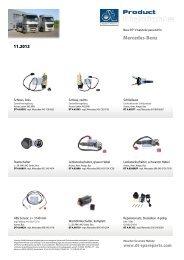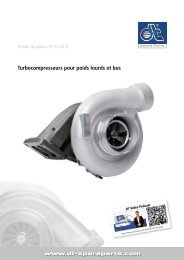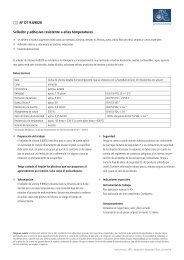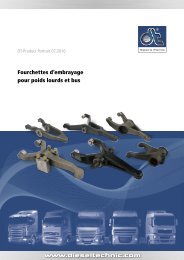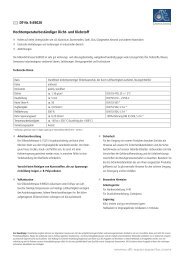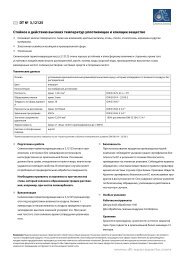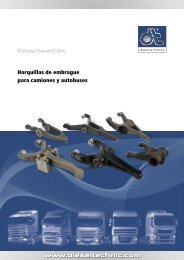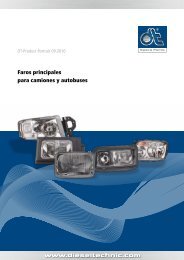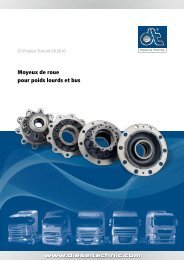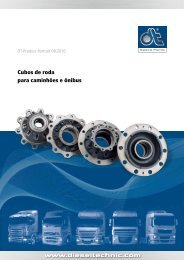1.16290 - Dieseltechnic.com
1.16290 - Dieseltechnic.com
1.16290 - Dieseltechnic.com
You also want an ePaper? Increase the reach of your titles
YUMPU automatically turns print PDFs into web optimized ePapers that Google loves.
EN<br />
DT-No. <strong>1.16290</strong><br />
High-temperature resistant sealant and adhesive<br />
� Adheres to many surfaces, such as Aluminium, non-ferrous metals, steel, glass, fibreglass, ceramic and other material<br />
� Elastic bonding and insulation in the industrial sector<br />
� Sealing<br />
The silicone sealant <strong>1.16290</strong> is very resistant to weathering and ageing, largely resistant to many solvents, oil, fuels, water, sea water, industrial waste gas,<br />
dilute acids, salt solutions, detergents and fruit acids.<br />
Technical data<br />
Basis Sturdy base-<strong>com</strong>ponent silicone rubber, which hardens in atmospheric moisture, solvent-free<br />
Colour anthracite<br />
Consistency paste, stable<br />
Density approx. 1,16 g/cm³ DIN 53 479, 23 +/- 2°C<br />
Skinning approx. 5 min DIN 50 014 – 23/50-2<br />
Shore hardness A approx. 50 DIN 53 505 *<br />
Tensile strength approx. 2,6 N/mm² DIN 53 504, S 3 A *<br />
Elongation at break 300 % DIN 53 504, S 3 A *<br />
Coefficient of expansion approx. 0,25 N/mm² 100% stretching DIN 53 504, S 3 A *<br />
Temperature stability approx. -40 to +230 °C (short term to +300°C)<br />
Binder system Acetate<br />
* Vulcanization measured after 14 days stored in a normal climate DIN 50 014 – 23/50-2<br />
� Work preparation<br />
The silicone sealant <strong>1.16290</strong> is ready for use and can be applied direct<br />
from the original container without mixing. The ground must be dry, free<br />
of dust and oil, otherwise a reduction in adhesion must be expected. In<br />
some cases the surface must be prepared beforehand.<br />
Take care when cleaning plastics with a tendency to stress<br />
cracking, i.e. Polycarbonate.<br />
� Vulkanization<br />
The silicone sealant <strong>1.16290</strong> cures under the influence of humidity.<br />
Low temperatures and low humidity slow down the curing process, higher<br />
values speed it up. When applied more thickly, the curing time is increased.<br />
� Safety<br />
When using our products, please observe the instructions in our ECmaterial<br />
safety data sheets and the safety instructions on packaging<br />
labels. In particular, the hazardous substances regulations and<br />
the accident prevention-regulations of the Institution for statutory<br />
accident insurance and prevention must be observed. Keep the ECmaterial<br />
safety data sheet for the products you are using on hand.<br />
It contains valuable advice on the safe handling, disposal and action<br />
in case of accident.<br />
� Special notes<br />
Working equipment:<br />
For manual processing of: H 40<br />
For <strong>com</strong>pressed air: Combi-press<br />
Storage:<br />
Store cool, dry and tightly closed<br />
Shelf life in original containers at least 12 months<br />
Please note: The above information can only provide general guidance. The listed properties and performance characteristics are only approximate values, these do not form part of our product specification.<br />
Due to conditions beyond our control, processing and application conditions and the variety of different materials, we advise carrying out sufficient tests of your own in all cases. A liability for the<br />
results can, therefore. not be derived from the information and instructions in this leaflet. Within the framework of our Terms and Conditions, a guarantee is only given for the consistently high quality of<br />
our products. With the publication of this issue, all previous technical data sheets cease to be valid.
DT-No. <strong>1.16290</strong><br />
EC-Material Safety Data Sheet<br />
According to regulation (EC) No. 1907/2006<br />
� Identification of substance/the preparation<br />
and the <strong>com</strong>pany<br />
Identification of the substance/the preparation<br />
Silicone sealer <strong>1.16290</strong><br />
Details of manufacturer/supplier<br />
Company name: DIESEL TECHNIC AG<br />
Street: Wehrmannsdamm 5-9<br />
Town: 27245 Kirchdorf/Deutschland<br />
Telephone: +49 (0)4273 89-0<br />
Telefax: +49 (0)4273 89-89<br />
E-Mail: info@dieseltechnic.<strong>com</strong><br />
Internet: www.dieseltechnic.<strong>com</strong><br />
� Possible hazards<br />
Classification<br />
This preparation is not classified as dangerous according to<br />
Regulation 1999/45/EG<br />
� First-aid measures<br />
First-aid after inhalation<br />
Provide fresh air. If problems persist, consult a doctor.<br />
First-aid after skin contact<br />
Remove mechanically (i.e. dab affected skin with cotton wool and tissues)<br />
and then wash thoroughly with water and a mild cleaner.<br />
First-aid after eye contact<br />
If the product gets into the eyes, rinse the open eye immediately with plenty<br />
of water for at least five minutes and then consult an eye specialist.<br />
First-aid after swallowing<br />
Call a doctor immediately.<br />
� Accidental release measures<br />
Personal precautions<br />
Ensure adequate ventilation. Remove all ignition sources. In the case of<br />
exposure to vapour, dust or aerosols respiratory protection should be used.<br />
Environmental protection measures<br />
Do not allow to get into drains or water courses.<br />
Cleaning measures<br />
Remove mechanically.<br />
� Composition/Details of <strong>com</strong>ponent parts<br />
Chemical characterisation (preparation)<br />
Hazardous substances:<br />
EG-No. CAS-No. Description %age Classification<br />
241-677-4 17689-77-9 Ethyltriacetoxysilane 1 - 5 % C R14-34<br />
224-221-9 4253-34-3 Methyltriacetoxysilane 1 - 5 % C R14-34<br />
� Fire-fighting measures<br />
Suitable extinguishing agents<br />
Water spray, alcohol-resistant foam, extinguishing powder, carbon<br />
dioxide (CO2).<br />
For safety reasons unsuitable extinguishing agents<br />
Water jet.<br />
Special hazards from the substance or preparation itself o<br />
<strong>com</strong>bustion products/gases<br />
In the case of fire, poisonous gases and vapours can be produced.<br />
Special protective fire-fighting equipment<br />
In case of fire: use ambient-air-independent breathing apparatus.<br />
� Handling and storage<br />
Handling<br />
Instructions for safe handling<br />
Ensure adequate ventilation and spot suction at critical points.<br />
Storage<br />
Requirements for storage rooms and containers<br />
Shafts and drains should be protected against penetration of the<br />
product.<br />
Instructions for mixed storage<br />
Keep away from food, beverages and feedstuffs.<br />
Additional instructions on storage conditions<br />
Protect from frost, heat, UV radiation/sunlight. Keep containers tightly<br />
closed and store in a cool, well-ventilated place.
� Limiting and monitoring of exposure/personal<br />
protective equipment<br />
Exposure limit values and monitoring of exposure limits<br />
and monitoring of exposure in the workplace<br />
Ascetic acid<br />
MAK: 25 mg/m³, 10 ml/m³<br />
DFG, EU (German research body)<br />
Protection and hygiene measures<br />
Keep away from food, beverages and feedstuffs.<br />
Wash hands before breaks and at end of work.<br />
Respiratory protection<br />
If technical suction or ventilation measures are not possible or<br />
inadequate, respiratory protection must be worn <strong>com</strong>bination filter<br />
unit (DIN EN 141)<br />
Hand protection<br />
Wear protective gloves even for brief hand contact.<br />
Eye protection<br />
Protective goggles.<br />
� Ecological information<br />
Ecological toxicity<br />
Do not allow to get into drains or water courses.<br />
� Instructions for disposal<br />
Re<strong>com</strong>mendation<br />
Disposal according to official regulations.<br />
Waste product<br />
Waste from MFSU of coatings (paints, varnishes, and enamels),<br />
adhesives, sealants and printing inks, waste MFSU of adhesives and<br />
sealants (including waterproofing products), adhesives and sealants<br />
containing organic solvents or other dangerous substances.<br />
(MFSU = Manufacture Formulation Supply and Use)<br />
Classified as hazardous waste.<br />
� Physical and chemical characteristics<br />
General Information<br />
Colour: anthracite<br />
Physical state: Paste<br />
Odour: pungent<br />
Important health and environmental protection and<br />
safety information<br />
Changes in state: Test standard<br />
Vapour pressure (at 20 °C): < 100 hPa<br />
Density (at 20 °C): 1,16 g/cm³<br />
Water solubility: insoluble<br />
� Stability and reactivity<br />
Hazardous de<strong>com</strong>position products<br />
On contact with water – formation of acetic acid.<br />
� Toxological Information<br />
Toxological tests<br />
Corrosive and irritant effects<br />
Frequent and prolonged skin contact may cause skin irritation.<br />
� Details of statutory regulations<br />
Designation<br />
National regulations<br />
Water hazard class: 1 – low hazard to water<br />
Status: Water hazard class – self-assessment<br />
(The data for the hazardous ingredients was taken from the last valid versions of the material safety data sheets of the pre-supplier.)



